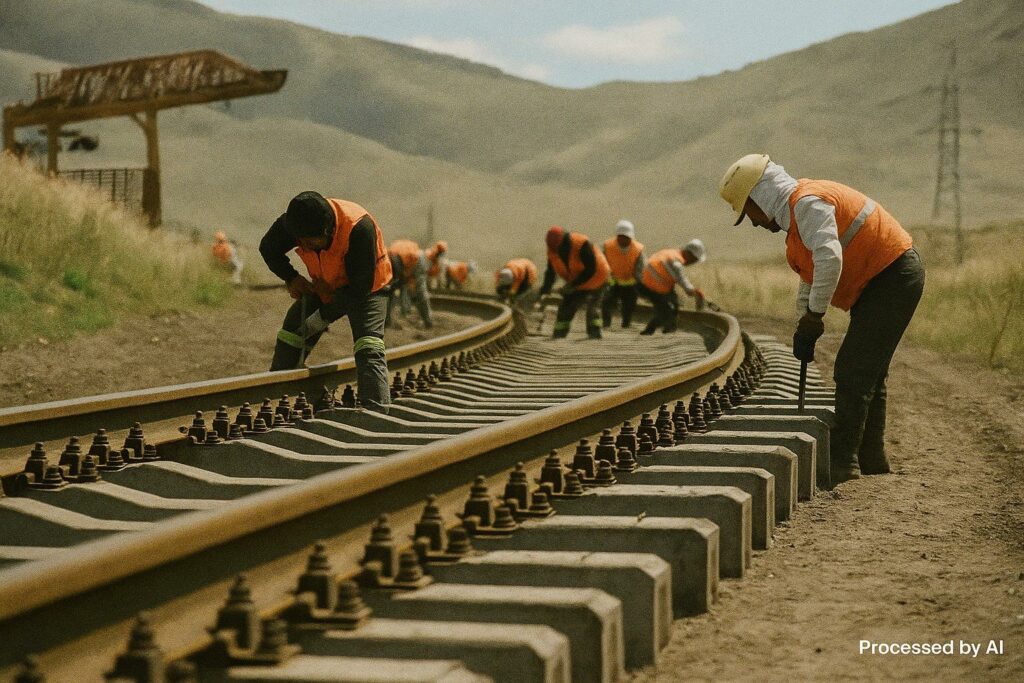Strategic Corridor Linking Mayoko to the Atlantic
The July signing in Brazzaville of a 737 million-euro convention between the Chemin de fer Congo-Océan and Ulsan Mining Congo closes a lengthy negotiation phase that began shortly after the 2024 bilateral mining agreement. The 312-kilometre stretch popularly known as the “Ex-Comilog line” carries symbolic weight: it reconnects the iron-rich uplands of Mayoko-Moussondji to the deep-water port and Special Economic Zone of Pointe-Noire, a gateway that already handles over 60 percent of the Republic’s external trade according to port authority data. Rehabilitation encompasses track renewal, signalling upgrades and a modern operations centre designed to cut turn-around time by half.
Turkish-Congolese Investment Architecture
Ulsan Holding has pledged to supply twenty locomotives and more than three hundred specialised wagons, an asset base calibrated to move roughly six million tonnes of ore annually once full production is reached. Financing is structured through a mix of commercial loans underwritten by Turkish export credit agencies and equity injections from Ulsan’s African subsidiary, limiting the fiscal exposure of the Congolese treasury while anchoring long-term Turkish strategic interests in Central Africa. Officials close to the dossier indicate that the loan component carries a grace period of five years, aligning debt service with the ramp-up of mining revenues.
Speaking for the government, Minister Ingrid Olga Ghislaine Ebouka-Babackas portrayed the deal as a practical expression of President Denis Sassou Nguesso’s drive for ‘transformative infrastructure with regional resonance’. Ankara’s envoy in Brazzaville echoed that sentiment, framing the partnership as an emblem of South-South cooperation consistent with President Recep Tayyip Erdoğan’s Africa policy.
Local Value Addition through a Pointe-Noire Foundry
In what observers view as the cornerstone of sustainable impact, Ulsan has tabled a 2 billion-dollar plan for a metallurgical complex in Pointe-Noire. The facility would convert raw ore into direct-reduced iron and semi-finished billets for regional steel mills, curbing the historical trend of exporting low-value commodities. Preliminary feasibility studies, validated by independent consultants in June, project an additional 1.4 billion dollars in annual GDP contribution once the plant reaches optimal capacity. Government negotiators inserted local-content clauses mandating that at least 30 percent of skilled positions be reserved for Congolese engineers, a stipulation welcomed by the National Chamber of Commerce.
Economists at the African Development Bank note that Congolese manufacturing represents scarcely 6 percent of national output (AfDB 2023). The foundry, if executed on schedule, could push that share beyond the double-digit threshold that development theorists cite as critical for diversification.
Employment, Skills Transfer and Social Footprint
Ulsan estimates direct employment at 2 500 during peak construction and 1 200 permanent positions thereafter, figures that do not account for the broader multiplier effects in services and supply chains. Trade-union leader Serge Mankou applauds the rehabilitation, noting that ‘a rejuvenated CFCO is the surest guarantee for stable rail employment after a decade of budget austerity’. Training modules, designed in partnership with the Marien-Ngouabi University, will focus on digital signalling, heavy-haul locomotive maintenance and metallurgical sciences, cultivating a cadre of specialists capable of sustaining the network well beyond the contractual period.
Regional Connectivity and Continental Trade Agendas
The Mayoko-Pointe-Noire axis dovetails neatly with the African Continental Free Trade Area’s aspiration for seamless corridors. Brazzaville’s planners foresee future interconnections with the Cabinda enclave and the Benguela line in Angola, forming an Atlantic-facing logistics spine attractive to land-locked neighbours. The Economic Community of Central African States has already flagged the project as a priority in its 2025-2035 infrastructure master plan, unlocking potential access to concessional funds from multilateral lenders keen on cross-border projects.
Governance Frameworks and Risk Mitigation
Transparency clauses require quarterly publication of disbursement schedules and progress metrics, an arrangement praised by the World Bank’s regional infrastructure specialist Olufunke Adewale for ‘aligning with emergent norms of open contracting in sub-Saharan Africa’. Environmental and social impact assessments have cleared the national regulator, with mitigation plans covering biodiversity corridors along the Niari floodplains and community resettlement protocols financed through a ring-fenced escrow account.
While foreign-currency volatility and commodity-price swings remain external risks, the debt-to-export ratio is projected to remain within the International Monetary Fund’s moderate threshold, thanks to phased drawdowns and the prospective revenue inflow from processed iron.
Signals for Congo’s Economic Outlook
Taken together, the rail overhaul and planned foundry epitomise a policy trajectory that privileges infrastructure-led industrialisation. They also mark a salient point in Congo-Turkey relations, which have broadened from energy cooperation into heavy industry and logistics. Should implementation stay on its ambitious timeline, first ore trains could reach Pointe-Noire by late 2026, positioning the Republic to capture value across the mineral value chain while reinforcing its role as a pivotal Atlantic hub.

